Day 18 began with about half of the group (the Mikuuls) eating at Miliki Mikuul while the rest of us ate at the hotel – we had the opportunity to choose where we wanted to have breakfast. After breakfast, we all set out on the two hour drive to Yendi.
On the bus, we were notified of the demise of the Queen Mother of Tamale, whom we met on our first full day in town. Her funeral procession took place on Sunday, the same day of her demise. We were reminded of the burial of the Dakpema’s Queen mother. — removing the stone from the top of the grave because they use the same burial place for all Dakpem queen mothers. On top of the stone, there is a pot of traditional brew which is refilled after each burial.
Yaa Naa’s Palace
Our first stop in Yendi, was the King’s Palace – which we are now accustomed to. It is important to pay homage to the King before proceeding to do whatever work you would like to do in his community. This King is the King of the Dagbon and rules over much of Northern Ghana because the Dagbon occupy most of the Northern Region of Ghana. Two differences that we noticed between him and other chiefs that we had visited before are that ; he had more security as well as a larger entourage which consisted of a secretary and a public relations officer. His security consisted of soldiers and a few policemen which we later connected to the fact that his predecessor was killed in conflict years ago. He also has a larger entourage because he is the King of other Dagbon chiefs. Another reason why we went to the Palace was to donate textbooks to an NGO that works in much Northern Ghana because throughout our stay, we have come to realise the quality of education, in this region, is a huge concern to the people. The King then expressed his gratitude and handed out Kola nuts – as per tradition. He then informed us that Professor Idrissu is actually a Prince in Dagbon – much to our surprise.
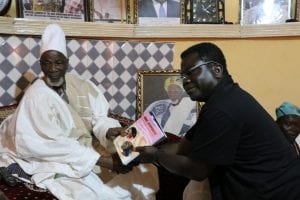
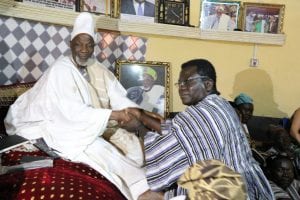
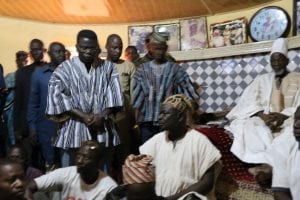
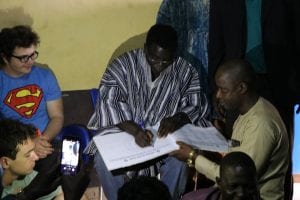
He expressed his gratitude to Professor Iddrisu for being an advocate for education; both in the US and here – through the textbook contribution. He shared a story that Professor’s ancestors sent him to school and he is now sharing that knowledge which shows that choosing to send him to school was a great investment. This, in part, shows one reason why parents may be inspired to send their children to school – so that they take care of the, when the parents can no longer take care of themselves as well as share their knowledge with the community, large. The King then voiced his interest in appointing Professor Iddrisu as a ruler of a section of Northern Ghana, upon his return from the US and presented him with a smock, a special privilege from the overlord of Dagbon.
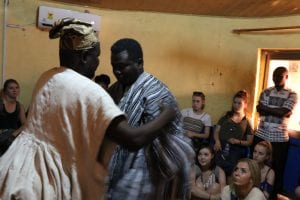
After which he was made to take a seat as tradition requires.

We were then challenged to respect him as we now know who he actually is and know that as a child of the royal household, he is protected by the prayers of his ancestors and the royal house, at large.
Gundo-Naa, Female paramount chief
The next stop was Gundogu Naa’s palace. She is another King in Yendi and holds the title of King instead of Queen because ruling is not a gendered role. The same way a CEO is called a CEO, regardless of their sex is the same way positions of power should be viewed. We had to wait outside of the palace for about 20 minutes before we were let inside and we later found out that she was being prepared for our visit. Gundogu Naa is the head of 8 other female chiefs who own land and rule over their households just as male chiefs do, again, because such roles are not separated by gender. She was the eldest daughter of the overload of Dagbon and it’s by that status she’s ascends to that position.
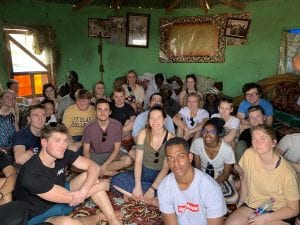
What was interesting was that her council is composed of men who are subordinate to her. This visit overall challenged how we normally view African women in positions of high authority because we rarely see any mentioned in literature.
She mentioned that nobody in Yendi had any ties to slavery or had descended from slavery because the community refused to take part in it. Because of the location of Yendi, this was hard to believe since it is very close to Salaga – the largest slave market in the Northern part of Ghana. In addition, this narrative has been common in multiple locations because of the shame and emotional burden of slavery, a fact too hard to handle. It also protects the image of Yendi – as a whole. Ironically, Babatu, a famous slave raider lived and was buried in Yendi.
The last stop was viewing the tomb of Babatu but the designated family member in charge of the relics and narrator refused to meet with us. Though Professor Iddrisu, through his contacts in Yendi had discussions on our visit. He argued that he was not gaining anything from meeting and talking to groups about Babatu and as a result, would rather not meet with us. We viewed his tomb which is dilapidated.
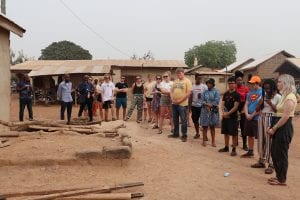
An important point that was raised in response to why we visited Babatu’s family and tomb was that in the process of interrogation, it is important to learn about the villain as we do the victims. Prof. Iddrisu noted that we are not celebrating Babatu but rather interrogating his actions. One lady who lives in Babatu’s rebuilt house let us in to show us the weapons of destruction that Babatu used.
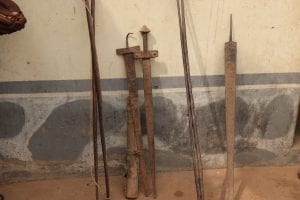
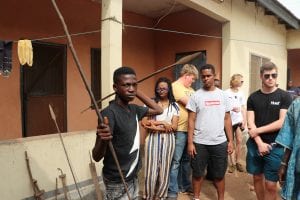
We had one boy posing with and demonstrating how, the weapons were used which was quite uncomfortable to watch.
We then headed back to Tamale where the remainder of the day, waited for dinner, and played volleyball.
